
Station Name: KIDLINGTON[Source: Nick Catford]
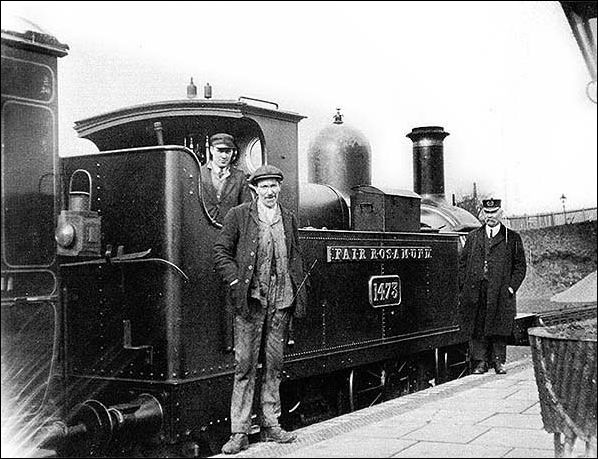 'Fair Rosamund' is seen in the bay platform at Kidlington in half cab form and with her numberplate centrally position on the side tank. Driver Bill Pomeroy is standing nearest the camera but his fireman, on the footplate, is unidentified. On the right is Kidlington stationmaster William Cooke. Mr Cooke was famous for his station gardens and the latticed planter partly visible on the right was one of several. Oxfordshire County Council records reveal several mentions of Mr Cooke and his stations’ gardens. In October 1926 Mr Cooke retired after fifty years service with the Great Western Railway of which thirty-six years were spent as stationmaster. Upon his retirement Mr Cooke was presented with a cheque by the Duke of Marlborough. This was the 9th Duke, Charles Spencer-Churchill, a cousin of Winston Churchill. On the rear of the locomotive's bunker the tools of the fireman's trade can be seen stowed while the lamp affixed to the carriage is of interest. The Great Western Railway's lamps were mounted via a side bracket as opposed to the more usual rear bracket. Unfortunately only part of the carriage number is visible and while we can only date this photograph to pre 1926 the presence of the lamp suggests the carriage was not an autotrailer. Driver Pomeroy retired in 1939 but his name was to crop up many years later on the occasion of the closure of the Woodstock branch. His son, also Bill, asked British Railways if his father could drive the final train but due to the length of time since his father had retired permission was not unreasonably refused. BR did however grant permission for Mr Pomeroy to travel on the footplate of the final train but whether this offer was taken up does not appear to have been recorded.
Photo from Jim Lake collection  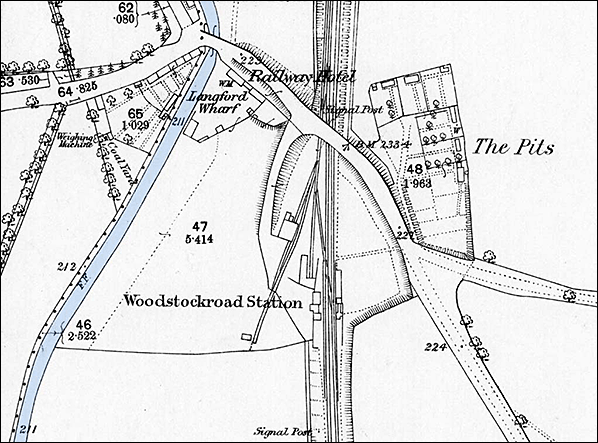
1877 1:2,500 OS map shows the original layout of Woodstock Road station before the opening of the Woodstock branch. Note the spelling Woodstockroad, this was never the name of the station. A loop and a short siding serving a dock are seen on what would later become the bay platform. At this time there was no footbridge, passengers needing to cross to the other platform using the barrow crossing at the south end of the station. No stationmaster's house is shown. The Railway Hotel is seen adjacent to Langford Wharf on the Oxford Canal. The hotel predated the railway, opening in the early 1700s as the Anchor Beer House. The name was changed to the Railway Hotel with the opening of the railway in 1855. After closure of the station in 1965 it was renamed the Wise Alderman in 1967 named in honour of signalman Frank Wise who manned the nearby signal box until his retirement in the mid 1960s.Since 2009 it has been the Highwayman Hotel.
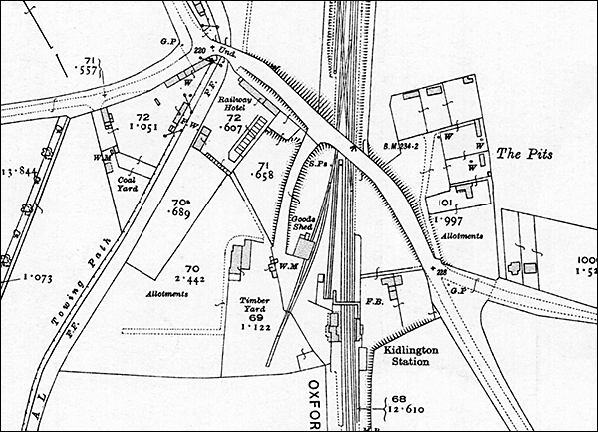
1922 1:2,500 OS map. The station was renamed Kidlington with the opening of the Woodstock branch in 1890. With the arrival of the Woodstock branch a bay platform was provided on the west side of the Down platform utilising the former dock. The bay also acted as a dock when required. From the late 19th century the goods shed siding also served a timber yard which required station passengers to cross the siding. A footbridge has now been provided on the north side of the platform buildings.
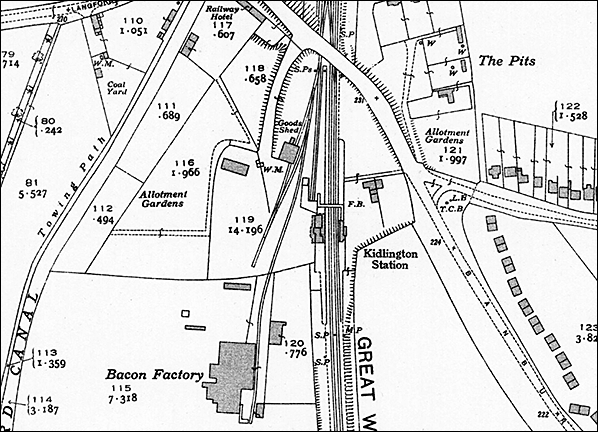 1938 OS map. The timber yard closed in the 1920s although its siding is still shown on this map. In 1923 a new siding was provided to serve a bacon factory which involved additional shunting across the station approach road. When the station opened it was a mile away from the village centre but by this date residential development of the village had almost reached the station with new housing to the east of the station.
old8.jpg)
Part of the station gardens at the London end of the Down platform, believed photographed in 1910. This was the work of stationmaster William Cooke who, unsurprisingly, was a noted keen gardener. Just about every gardenesque item visible is made from branches and logs; four planters; two benches and some arch and trellis work. Mr Cooke regularly won awards and there was some hopefully friendly rivalry between Mr Cooke and Mr Ashford, the Woodstock stationmaster of the same period. On the London end of Kidlington's Up platform was some extensive and elaborate trellis work which formed an enclosure and again was made from branches. At Woodstock there was a nook with wooden bench similar to that on the left, except that the bench at Woodstock was a standard GWR wooden item. It was located some way along Woodstock's platform and was rarely photographed. Following the period of railway closures in the 1950s and 1960s comments have often been made about stations being so quiet the staff had ample time to tend gardens and allotments. While this was not untrue, staff did not shirk their duties and much of the gardening was done in their own time, especially in the run-up to the 'Best Kept' competitions. At Kidlington, Mr Cooke no doubt had plenty of willing helpers. On the right we can see the footbridge still has its roof and in the right background stands the original Banbury Road bridge which was to be rebuilt in 1925. The roof of the goods shed is visible centre background
Photo from John Mann collection old7.jpg)
Kidlington believed circa 1930 and a northbound main line train formed, insofar as can be seen, of clerestory stock, the first two vehicles being in chocolate and cream livery. By 1930 traffic at Kidlington had tailed off, a process which began following the First World War, although in this scene a fair few people are present. We cannot of course see further along the platform but the cluster of people in the vicinity of the Woodstock bay suggests they had arrived from Woodstock and are changing trains. For how long they had been awaiting the connection is, however, another matter. The locomotive of the main line train is a 3800, or 'County', Class 4-4-0 and believed to be No. 3806 'County Kildare' but neither number or name are readable in this view, nor are they readable in the accompanying close-up view. Indeed, in the close up view the second word of the name appears to be longer than 'Kildare' and could be 'Kilkenny' which was No. 3807. Nevertheless, in the absence of a clearer photograph we just have to assume 'County Kildare' to be correct. All the 'County' 4-4-0s had been withdrawn by the end of 1933, the final example being No. 3834 'County of Somerset' which bowed out on 24 November 1933 with 'County Kildare' bowing out in February 1931. In the bay sits the Woodstock autotrain headed by 'Fair Rosamund' The autotrailer is one of the early slab-sided cars and might have been No. 110 which was a Woodstock branch regular at this time. Oil lamps are still present on the platforms but the new concrete posts for the Tilley 'Challow' lamps are starting to appear; these were commissioned in 1931 so the photograph being taken in 1930 is not far off the mark. Note the white painted guard rails for the manual point levers and the white base of the telegraph pole; this would have been necessary for safety reasons when the station was lit by wick lamps. One of the new concrete posts has been positioned to illuminate the siding pointwork. On the bracket signal the arm for the Woodstock branch is 'Off'. The other arm, on the taller dolly, controlled the connection to the Down main line.
Photo from John Mann collection old6.jpg)
A closer view of the County Class 4-4-0 at Kidlington c. 1930. This photograph is assumed to have been taken slightly later as by now most of the people on the platform have disappeared. Whether the train lingered at Kidlington for a few minutes, as could happen if mail, parcels and sundries needed loading and unloading, or if two photographers were present is not known. The vantage point for this shot was near the north end of the goods shed.
Photo from John Mann collection old1.jpg) Saint class 4-6-0 No. 2981 'Ivanhoe' waits at Kidlington with a Down local train. This locomotive was one of the batch built as unnamed 4-4-2 machines, in this case as No. 181 in 1905 and rebuilt to 4-6-0 in 1912. The Saint class comprised a number of sub classes defined by name; Court, Lady, Saint and Scott with the latter referring to Sir Walter Scott. 'Ivanhoe' was thus a member of the Scott sub class. She is seen here carrying a Banbury (84C) shedplate, which code was applied during or shortly after February 1950. 'Ivanhoe' was withdrawn in March 1951, therefore we have an approximate one year date window for this photograph. To the right the Woodstock autotrain waits in the bay platform. The 1400 Class locomotive carries a shedplate, just visible, but has still to acquire a smokebox numberplate. On the platform two people are heading towards the branch train while a perambulator and some bags are about to be loaded into the van of the main line train. The scene is ostensibly quite busy but close examination reveals many of the persons there present are staff, a not unusual scenario at many rural stations. The platform lighting is worth a mention. Until 1931 oil (wick) lighting was used. This was replaced by Tilley paraffin/pressure 'Challow' lamps, so-named after the first GWR station to use them, suspended from brackets atop the replacement concrete posts seen here. These lamps would be serviced, filled with paraffin and fired-up in the lamp room and then hoisted to the top of the lamp post. The hoisting equipment is just discernible on the post immediate ahead of the camera. This form of lighting remained in use until the station closed in 1964. After closure the footbridge was dismantled and taken to Didcot North Junction where components were used in construction of a replacement, albeit it with a longer deck, for the original footbridge which had burned down. This footbridge is today a popular vantage point for railway photographers.
Photo from John Mann collection old4.jpg)
Photographed from a Down stopping train, the Woodstock autotrain awaits custom, apparently in vain, in the bay platform. The date is sometime between 1950 and, of course, closure of the Woodstock branch. The locomotive is a 5400 class 0-6-0 Pannier Tank but its precise identity is unclear. In the BR period two of this class, the other being No. 5414, were shedded at Oxford but No. 5414 was transferred away in January 1950 while No. 5413 remained in the area until after the Woodstock branch closed. There were only 25, or 26 depending upon point of view, members of the 5400 class. The prototype was a conversion from a Saddle Tank but scrapped in 1930 and replaced by a new build Pannier Tank given the same number. All the 25 new build locomotives were auto fitted. The class had larger driving wheels compared to their contemporary Pannier Tanks and this gave them a slightly antiquated appearance. Nevertheless they were ideal for autotrain work and were popular with crews working the Woodstock branch, being much more sure footed than the 0-4-2 tanks which they deputised for when necessary. On the right, the goods shed gates have either been replaced by a tarpaulin or covered by one for some unknown reason. A rather ancient cattle wagon can be seen (at one time there was a cattle market to the west of the station but it had disappeared by the 1950s) while a motor lorry is loading or unloading alongside a box van, presumably because the goods shed was inaccessible. The bacon factory can be seen in the background. Some Woodstock trains offered reasonable connections at Kidlington but many did not and this is often cited, not unreasonably, to have been one reason for the demise of the Woodstock branch. While this photograph appears to show a good connection, the autotrain may still have had a considerable time to wait before departure although it does appear the locomotive's fire has just been stoked in readiness.
Photo from John Mann collection old2.jpg)
The days of stationmaster Cooke's quite spectacular station gardens, which were predominantly at the London end of the station, have long gone and the station is now looking very rundown which was perhaps a legacy of wartime. A bench remains on the Up platform and a barrow remains on the Down platform, outside the station building, but the GWR bench which had sat on the Down platform just ahead of the footbridge stairs has disappeared. Note the British Railways van on the forecourt which would have been in the attractive red and cream livery. The vehicle is a Morris Commercial NV Series, introduced in 1950 and widely used by British Railways. This provides us with an earliest date for the photograph which has otherwise proved difficult to date. The conclusion is that it is around the time of withdrawal of the Woodstock service in 1954. The goods shed clearly displays its broad gauge origins as does the track spacing (the so-called '6ft') on the main line. The rusting rails into the goods shed indicate the shed hasn't been used for quite some time. The track branching off to the right was simply a loop avoiding the goods shed road. It rejoined the track upon which the van stands, the connection being hidden by the goods shed. From the late 19th century the siding had served a timber yard but this disappeared c.1920 and the siding was realigned to serve a bacon factory which dated from 1923 and was originally rather pompously titled 'The Oxfordshire Farmers' Co-operative Bacon Factory Limited'. The title was later shortened to 'Kidlington Bacon Factory' and ultimately became part of the Wiltshire based Harris empire. The factory can be seen here, background right of centre. During the Second World War the bacon factory siding was used by the Air Ministry in connection with RAF Kidlington, out of view to the right of this view. As can be imagined, shunting across the station approach road proved to be a nuisance for the public wishing to leave or arrive at the station. Indeed one source claims the public were barred from using the approach road when shunting was ongoing but probably in reality safe passage was overseen by a member of staff. The bacon factory siding, once across the approach road, then ran in the street although the 'street' was actually the factory's own access road. The factory closed in the mid 1960s and the private siding agreement was formally terminated by British Rail in 1966. One might wonder about the vantage point of this photograph. The skewed road bridge, which had been rebuilt in 1925, was some 150 yards north of the station when measured from the station building and the extended Down platform ran right up to it. It is suspected this photograph was taken from the bridge either with a zoom lens or subsequently cropped. One feature this elevated view does clearly show is the extension to the Down Platform, provided when the Woodstock branch opened in 1890. The track in the bay had originally been nothing more than a siding serving the goods dock, which explains why Woodstock passenger trains ran into what was essentially still a goods dock as it remained usable as such.
Photo from John Mann collection Click here for Kidlington Station Gallery 2:
|
 Some five miles north of Oxford lies the village of Kidlington which today has spread westwards towards the railway but in the 19th century was one mile away across open countryside and of course the centre of the village still is. The history of a railway station in this locality can be quite confusing. Langford Lane station was opened in April 1855 adjacent to the road of that name and in July of the same year was renamed ‘Woodstock Road’. This caused a problem further north where there was a pre-existing station named ‘Woodstock’ opened in 1850 and renamed ‘Woodstock Road’ the following year; this was renamed ‘Kirtlington’ but due to confusion with Kidlington, actual or perceived, which Langford Lane/Woodstock Road became in 1890 was renamed again to Bletchington (alternatively spelled Bletchingdon). Nothing is known about Langford Lane station other than its dates of operation under that name and that it would have had two platforms as by 1855 the single track broad gauge line had been doubled; neither is it clear if what became Woodstock Road was a straightforward renaming, as is usually claimed, or a new station - most likely the former. Therefore and as can be seen there have been two stations named ‘Woodstock Road’, neither of which were anywhere near the town of Woodstock.
Some five miles north of Oxford lies the village of Kidlington which today has spread westwards towards the railway but in the 19th century was one mile away across open countryside and of course the centre of the village still is. The history of a railway station in this locality can be quite confusing. Langford Lane station was opened in April 1855 adjacent to the road of that name and in July of the same year was renamed ‘Woodstock Road’. This caused a problem further north where there was a pre-existing station named ‘Woodstock’ opened in 1850 and renamed ‘Woodstock Road’ the following year; this was renamed ‘Kirtlington’ but due to confusion with Kidlington, actual or perceived, which Langford Lane/Woodstock Road became in 1890 was renamed again to Bletchington (alternatively spelled Bletchingdon). Nothing is known about Langford Lane station other than its dates of operation under that name and that it would have had two platforms as by 1855 the single track broad gauge line had been doubled; neither is it clear if what became Woodstock Road was a straightforward renaming, as is usually claimed, or a new station - most likely the former. Therefore and as can be seen there have been two stations named ‘Woodstock Road’, neither of which were anywhere near the town of Woodstock. With the opening of the Woodstock branch, Woodstock Road, that is the former Langford Lane version, reputedly became ‘Kidlington for Blenheim’ on 19 May 1890 but photographic evidence exists showing that in or by the early 20th century the running-in boards announced ‘Kidlington change for Blenheim & Woodstock’ which by that time was rather more informative than simply ‘ Kidlington for Blenheim’. The usual layout of railway stations placed the station buildings, or at least the main buildings, on the side of the line closest to the town or village that the stations purported to serve even if that town or village was miles away which it quite often was. Kidlington was no exception and as a hark back to its ‘Woodstock Road’ days the main buildings were on the west side of the line, closest side to the town of Woodstock some three miles away to the north-west as the proverbial crow flies.
With the opening of the Woodstock branch, Woodstock Road, that is the former Langford Lane version, reputedly became ‘Kidlington for Blenheim’ on 19 May 1890 but photographic evidence exists showing that in or by the early 20th century the running-in boards announced ‘Kidlington change for Blenheim & Woodstock’ which by that time was rather more informative than simply ‘ Kidlington for Blenheim’. The usual layout of railway stations placed the station buildings, or at least the main buildings, on the side of the line closest to the town or village that the stations purported to serve even if that town or village was miles away which it quite often was. Kidlington was no exception and as a hark back to its ‘Woodstock Road’ days the main buildings were on the west side of the line, closest side to the town of Woodstock some three miles away to the north-west as the proverbial crow flies. Kidlington goods yard was a simple affair comprising originally one and later two sidings plus a loop avoiding the goods shed. The shed measured 57ft by 40ft, had five bays divided by brick pilasters and was built to accommodate the broad gauge. Internally there was a 1½ ton crane and a small office was located on the north elevation. Road vehicle access was at the shed's west side. Further details, such as exist, can be found in the applicable image captions but a description of how the goods yard was operated is given later.
Kidlington goods yard was a simple affair comprising originally one and later two sidings plus a loop avoiding the goods shed. The shed measured 57ft by 40ft, had five bays divided by brick pilasters and was built to accommodate the broad gauge. Internally there was a 1½ ton crane and a small office was located on the north elevation. Road vehicle access was at the shed's west side. Further details, such as exist, can be found in the applicable image captions but a description of how the goods yard was operated is given later.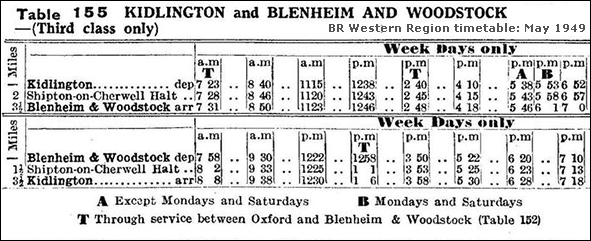
 In 1910 the 'cut off' line between what thereafter was Ashendon Junction and Aynho Junction was opened. It was the creation of this stretch of railway which left the original main line through Akeman Street to Grendon Underwood Junction as something of a sleepy backwater. This new line therefore bypassed Oxford and provided a quicker route for Paddington - Birmingham and beyond trains. Many trains, passenger and goods, were thus diverted with the result being the Didcot - Oxford - Banbury line becoming much quieter and especially north of Oxford on which section Kidlington was located. Nevertheless World War Two brought heavy traffic to the line as indeed happened across much of the country and it was deemed necessary to provide another Down loop north of Kidlington and this is the loop, south of the footbridge, mentioned. Following closure of the Woodstock branch in 1954 the final 40 chains to Kidlington was used to form a loop which had a capacity of 68 wagons.
In 1910 the 'cut off' line between what thereafter was Ashendon Junction and Aynho Junction was opened. It was the creation of this stretch of railway which left the original main line through Akeman Street to Grendon Underwood Junction as something of a sleepy backwater. This new line therefore bypassed Oxford and provided a quicker route for Paddington - Birmingham and beyond trains. Many trains, passenger and goods, were thus diverted with the result being the Didcot - Oxford - Banbury line becoming much quieter and especially north of Oxford on which section Kidlington was located. Nevertheless World War Two brought heavy traffic to the line as indeed happened across much of the country and it was deemed necessary to provide another Down loop north of Kidlington and this is the loop, south of the footbridge, mentioned. Following closure of the Woodstock branch in 1954 the final 40 chains to Kidlington was used to form a loop which had a capacity of 68 wagons. A very similar shunting procedure was followed at Woodstock, again usually with the autotrailer still attached, but there was one difference. At Woodstock the goods shed was of course designed for standard gauge track and care had to be taken to ensure the steps of the autotrailer were fully retracted, otherwise they could foul the entrance to the shed. The goods shed at Kidlington, however, had been built to accommodate broad gauge track so this potential problem did not exist and although the standard gauge track entering the shed was offset relative to the rail entrances, to allow use of the original internal platform without modification, adequate clearance nevertheless remained.
A very similar shunting procedure was followed at Woodstock, again usually with the autotrailer still attached, but there was one difference. At Woodstock the goods shed was of course designed for standard gauge track and care had to be taken to ensure the steps of the autotrailer were fully retracted, otherwise they could foul the entrance to the shed. The goods shed at Kidlington, however, had been built to accommodate broad gauge track so this potential problem did not exist and although the standard gauge track entering the shed was offset relative to the rail entrances, to allow use of the original internal platform without modification, adequate clearance nevertheless remained.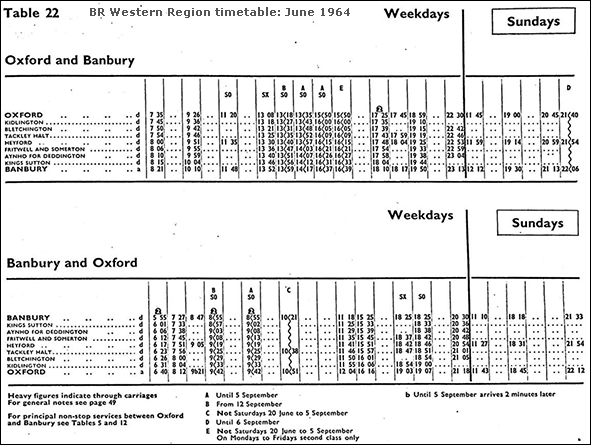
 The passenger station had been erased by 1973 with the exception of the Down side building which was taken over by a succession of businesses. Details of some of these can be found in the applicable images and their captions. In 1990 the building suffered fire damage and was subsequently demolished although some cast iron canopy brackets were recovered and taken to Didcot and used for the rebuilding of Heyford station. By this time the building was hemmed-in between the railway and the expanding industrial estate and it looked most incongruous, or the industrial estate did depending, upon one's point of view. Meanwhile, up the line at Didcot North Junction a tanker train derailment on 14 August 1964 started a fire which seriously damaged the existing footbridge at the location. The cause of the accident is thought to have been nothing more than a misunderstanding between driver and signalman. Eventually, although the precise date is unknown, the footbridge at Kidlington was dismantled and its component parts used for a replacement footbridge at Didcot North Junction. It was still there in the summer of 2023.
The passenger station had been erased by 1973 with the exception of the Down side building which was taken over by a succession of businesses. Details of some of these can be found in the applicable images and their captions. In 1990 the building suffered fire damage and was subsequently demolished although some cast iron canopy brackets were recovered and taken to Didcot and used for the rebuilding of Heyford station. By this time the building was hemmed-in between the railway and the expanding industrial estate and it looked most incongruous, or the industrial estate did depending, upon one's point of view. Meanwhile, up the line at Didcot North Junction a tanker train derailment on 14 August 1964 started a fire which seriously damaged the existing footbridge at the location. The cause of the accident is thought to have been nothing more than a misunderstanding between driver and signalman. Eventually, although the precise date is unknown, the footbridge at Kidlington was dismantled and its component parts used for a replacement footbridge at Didcot North Junction. It was still there in the summer of 2023.
 Home Page
Home Page